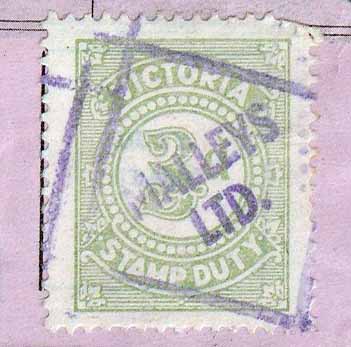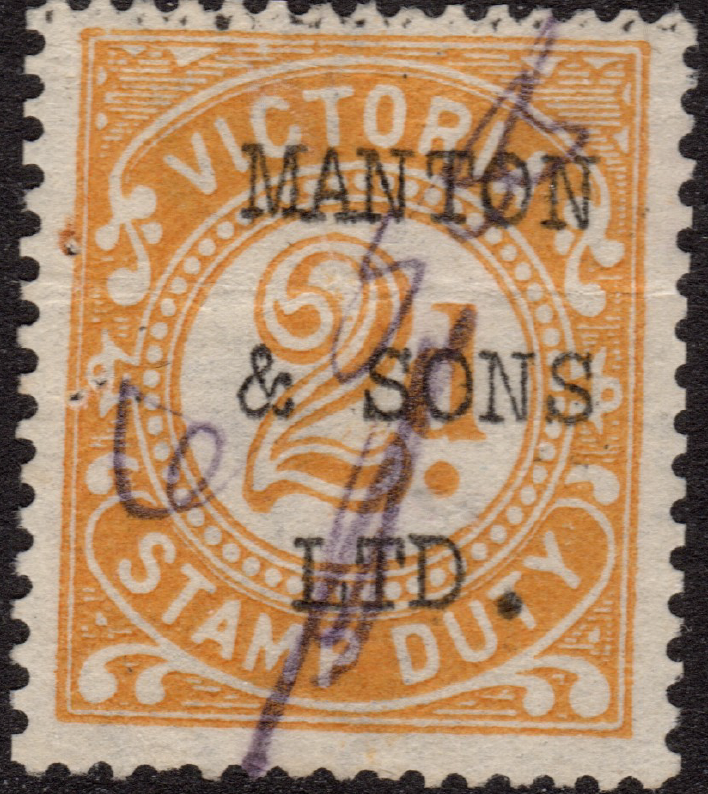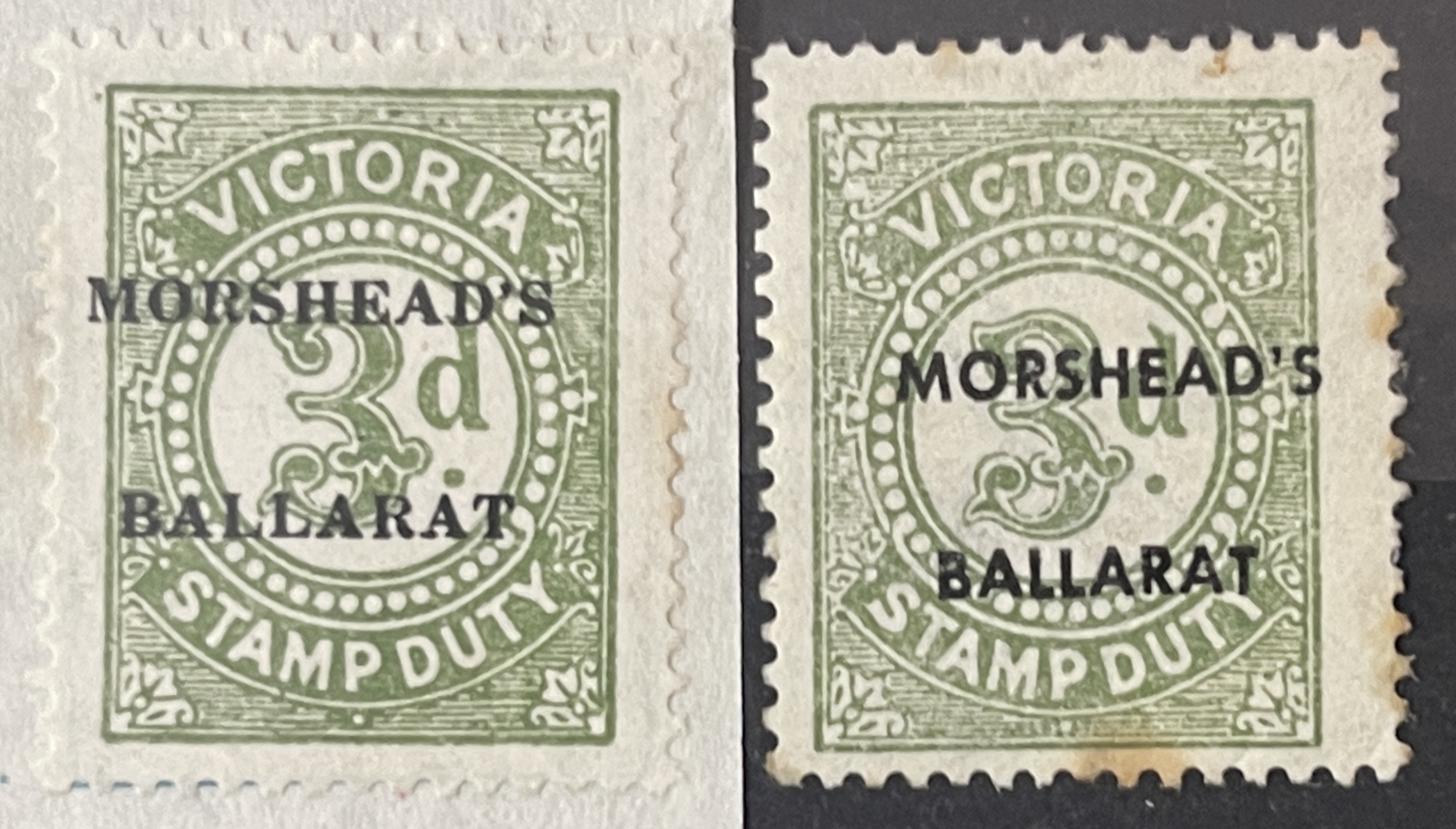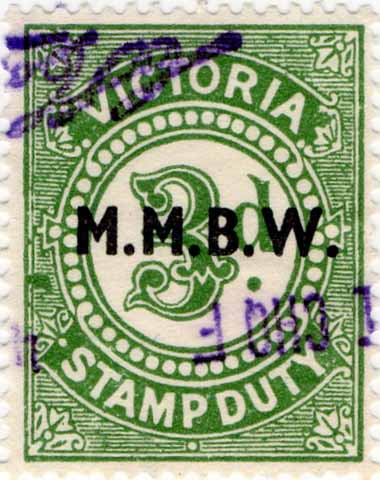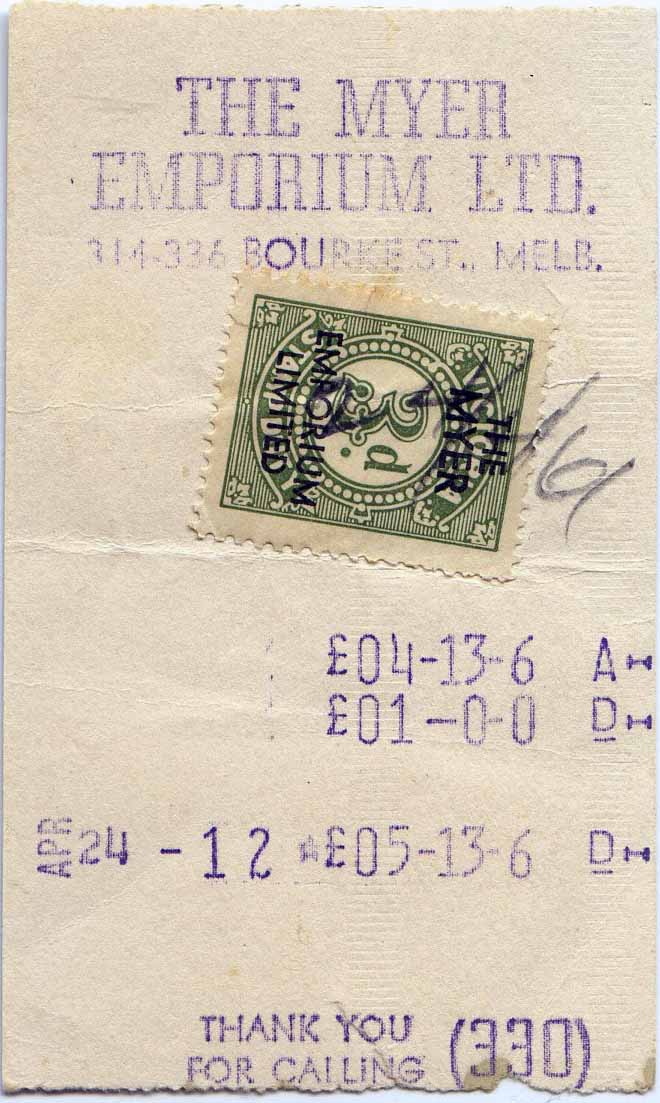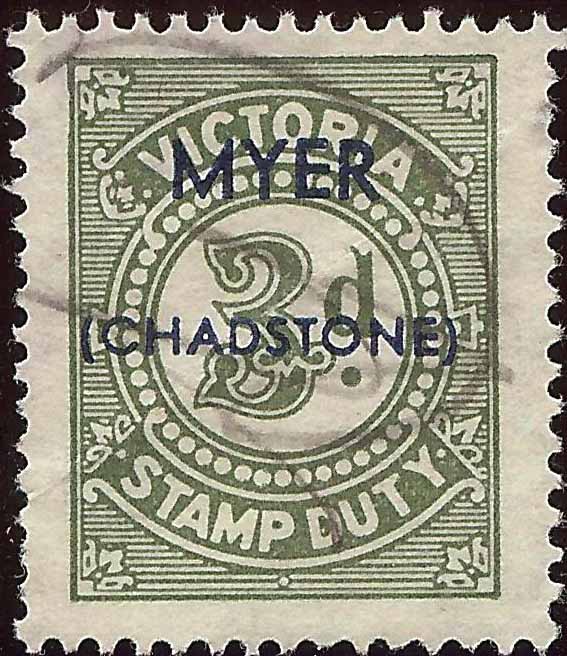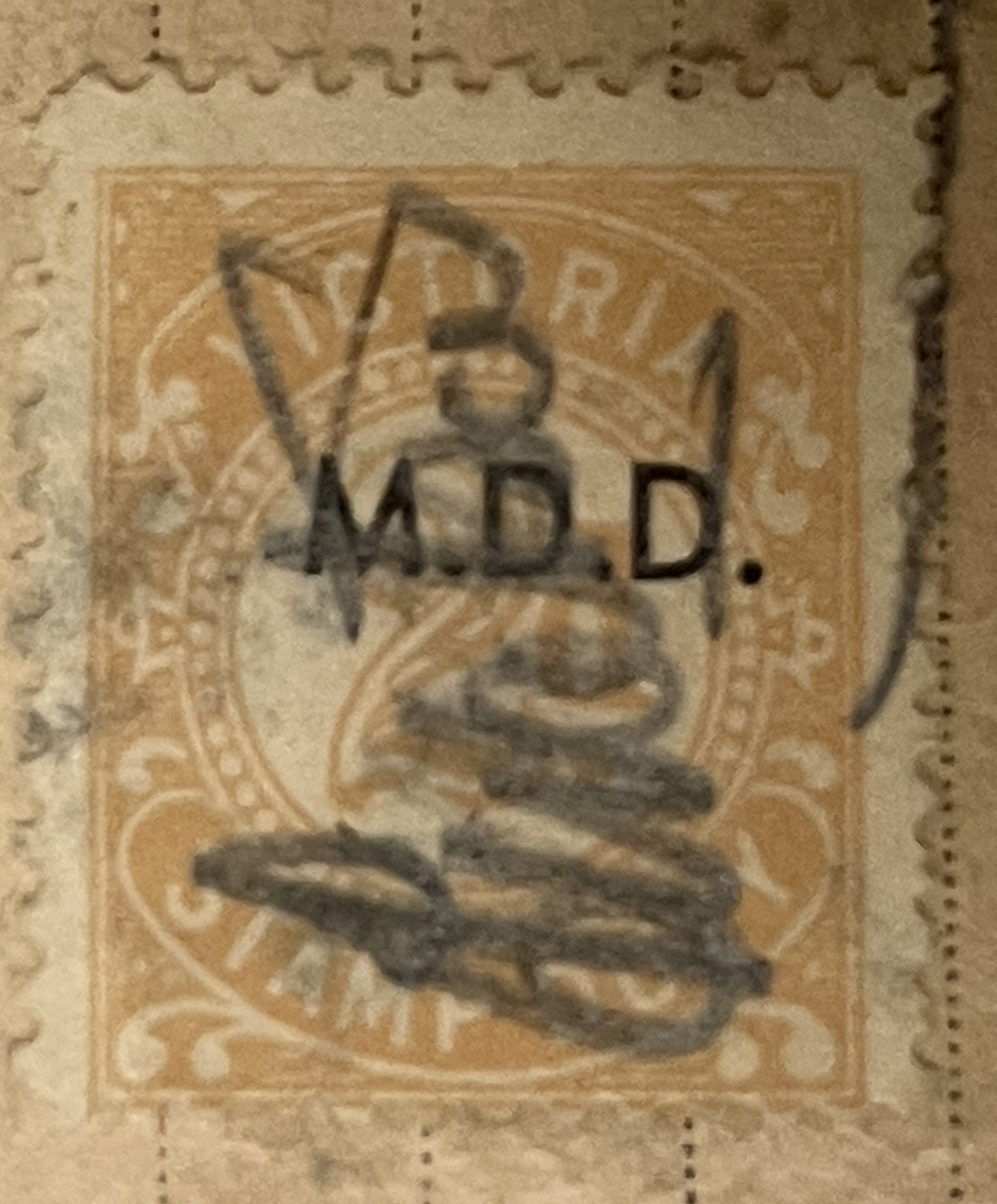|
Private Revenue Perfins of Victoria An Elsmore Coath Howard production The authors would welcome your comments additions or input into this work A B C D E F G H I J K L M N O P Q R S T V W Y Back to Victoria 'Other' page Back to States Perfin index Back to Commercial Overprint index Section 2 - Commercial Overprints M -------------------------------------------------------- MALLEYS/LTD..a User: Malleys Ltd Department Store Address: St, Melbourne, VIC Revenue Use: 1932 Series 3d Rarity Scale:
1932 Series 3d R3 Background: Francis Malley was born in 1863 in Gosford, New South Wales. Moving to Sydney, he trained as a sheet metal worker before starting his own business in1885, at 273 Sussex Street, servicing the building and plumbing trades. By 1890, he had moved to Harbour Street, Darling Harbour. In 1892, the business moved to larger premises at 86 Liverpool Street, corner of Kent Street. Further expansion resulted in a move, in 1910, to 50 Mountain Street, Broadway,(the Liverpool Street facility remained the Head Office and showroom) and the formation of F. Malleys and Sons Ltd under the control of Francis Malley and two of his sons, twins Charles and Clyde Malley (b. 1885).
Francis Malley retired in 1912, control of the company continuing under Charles and Clyde Malley. He died at his Cremorne home in June, 1932.
In 1915, business expanded with the use of agents in Dubbo, Penrith, Orange and other country centres. The demands of war production (World War 1) saw rapid industrial expansion necessitating reconstruction. F. Malley and Sons Ltd was wound up in September 1919, and trading commenced as Malleys Ltd, a limited liability company. Three acres of land at Alexandria were purchased in 1922 for a new factory (built by Harry Thompson) which was occupied in October, 1923.
The company continued to make rapid progress in manufacturing but sold solely through distributors until 1919 when a chain of retail hardware stores was set up in the Sydney metropolitan area. These were all disposed of in 1951 and the company’s products sold through normal retailers.
Following war production work (World War 2), Malley’s expanded rapidly not only in the original sheet metal engineering business but in the development of a range of household appliances.
In 1946, eleven acres were acquired at Auburn (Sydney) to provide for further factory expansion. Malley’s manufacturing activities were greatly increased by the absorption of other, similar manufacturers such as United Metal Industries which, in 1961 became a wholly owned subsidiary of Malleys Ltd.
In 1958, Malleys entered into a licensing agreement with U.S. Company, Whirlpool Corp, which launched the distribution of Whirlpool products under the brand Malleys Whirlpool. (The Australian office of Whirlpool, at Scoresby, Victoria, did not open until 1990.)
By the mid-1960s Malleys had manufacturing plants at Auburn and Alexandria in Sydney, Woolloongabba in Queensland, and selling agencies in Melbourne, Brisbane, Adelaide, Newcastle and Canberra, as well as agencies in Western Australia and Tasmania.
Malley’s Ltd was taken over by Simpson Pope Holdings Ltd on 25 July, 1979, and the company was de-listed in September, 1983. Device: Handstamp Related Patterns: Nil -------------------------------------------------------- MANTONS..a User: Manton & Sons Ltd Department Store Address: 226-236 Bourke St, Melbourne, VIC Revenue Use: 1915 Series 2d Rarity Scale:
1915 Series 2d R4 Background: William Vaughan Manton, the second son of George John Manton, one time miner turned mine manager and mining finance agent, (died by 1902) was born in Ballarat, in 1874. As a young man, Manton joined the drapery emporium of John Snow & Co. (established about 1892) of Sturt Street, Ballarat. In early 1909, he put his villa residence on the market “owing to his leaving to reside in Sydney”; it sold in May, 1911. William Manton in Melbourne in 1902. There were two sons and a daughter of the marriage; his sons, Ivor Vaughan Manton and John (Jack) would eventually join him in the family business he founded. In October, 1911, John Snow & Co. was registered as a proprietary company, with John Snow as governing director and his son, Sydney Snow, and William Vaughan Manton as directors. “Sydney Snow Stores, Limited” opened at the corner of Pitt and Liverpool streets, Sydney, in 1912. The firm continued to trade in Ballarat. On 12 May, 1926, Manton and Paull Pty Ltd announced a brand new ( four storey department) store located at 240-246 Bourke Street, next to the Hoyts cinema, would begin “Tomorrow its reign of service to Greater Melbourne’s million”. In December, 1925, however, the business of Manton and Paull was sending a travelling sales ladies’ wear representative to country towns in Victoria. Mantons 1926 Manton and Paull Pty Ltd appear to have ceased trading in 1930, Manton and Sons Pty Ltd first advertising under that name in June, 1932. No trace has been found as to the identity of Paull. In August 1933, Manton and Sons Pty Ltd acquired the Theatre Royal, adjacent to their existing premises, from J.C. Williamsons, with plans to erect a three-storey building “distinguished by many of the best features of the modern stores of Europe and the United States”. The building, at 236 Bourke Street, opened in March 1934. In the same month, Manton sold his Mosman (Sydney) mansion “on account of his permanent residence in Melbourne”. In late 1934, the firm acquired a site adjacent to the east of their just opened store and announced that, “Owing to the rapid expansion of the business activities of Manton and Sons Pty Ltd” was embarking “an entirely new building programme at the cost of £80,000”. In January, 1937, work commenced on the erection of extensions, which included a new four storey structure in Little Bourke Street. The brick and concrete additions included placing an extra floor on the “mushroom” style Art Deco building in Bourke Street and the creation of a basement and sub-basement. In February, 1937, Manton and Sons, 236 Bourke Street, listed as a public company with 140,000 preference shares of £1 each. Among the directors were William Vaughan Manton, Ivor Vaughan Manton and John Manton. Mantons 1943 In May, 1955, G.J. Coles bought out Manton and Sons Ltd for £2 million, the firm closing six months later. In the 1970s, the architecturally significant building was covered in cladding. Today, the building is home to a Target store. William Vaughan Manton died in South Yarra in early 1962. Device: Handstamp Related Patterns: Nil -------------------------------------------------------- MAPLES..a User: Maples Piano & Furnature Warehouse Address: 256-264 Clarendon St, Melbourne, VIC Chapel St, Prahran, VIC Revenue Use: 1915 Series 2d Rarity Scale:
1915 Series 2d R4 Background: Benjamin Nathan, son of Benjamin and Eliza Nathan, was born in 1864 in Collingwood into a large family. Benjamin is reputed to be the co-founder of Maples Stores together with Frederick Thomas, the pair being listed together in a 1906 court case along with R(ueben?) Nathan and Joseph Nathan as responsible partners in Maples. Frederick Thomas appears as the signatory representing Maples, in April, 1906, on an agreement for Maples to be sole Victorian and Tasmanian agents for British piano maker, H.G. Brinsmead. It is probable however that Benjamin gained his trading experience under his brother, Simeon who was already in the furniture warehouse business in May, 1889, at ‘The Furnishing Arcade’, 225 Elizabeth Street. Simeon opened a new furnishing warehouse in December, 1889, at 248-258 Swanston Street, using exactly the same advertising methods and time payment system, as well as offering free packing and delivery to the railhead for country purchasers, as would later be used by Maples stores. After the disastrous ‘Great Swanston Street Fire’ in early 1890, Simeon Nathan re-located to 233 Elizabeth Street. In the meantime, Benjamin Nathan (described as ‘the younger’ in 1903) aged 26, representing B. Nathan & Co., had engaged architect Robert Worden to design a 3 storey warehouse in Chapel Street, Prahran, tenders for its construction being called in April, 1890. In December, 1890, Benjamin Nathan’s store opened at 319-321 Chapel Street, Prahran. The use of the name ‘Maples’ (relying on the prestige of the totally unconnected Maples & Co. of London) does not occur until 20 May, 1893, when the store at 186-190 Clarendon Street, South Melbourne, is also mentioned for the first time. The stores specialised in pianos (29 makes) and organs but also offered complete furnishing for any home. In October, 1895, the connection between Simeon and Benjamin is confirmed when S. Nathan & Co. gave their address as 319-321 Chapel Street, Prahran, and 184-190 Clarendon Street, South Melbourne. By 1899, “Maples Complete Furnishing Warehouse” advertised as “The cheapest in Australia” with “furniture sent all over Australia”. The firm offered a large mail order catalogue and the option of exchange within a 12 month period on pianos “without any loss”. In 1899, the firm held the lease on a two storey brick warehouse, shop and dwelling in North Melbourne, on the corner of Victoria and Errol streets, and was planning to re-build the South Melbourne premises. Of interest in the business structure of the company, Maples in Errol Street and the later chain of furniture stores throughout the suburbs advertised separately from the Prahran and South Melbourne stores which always advertised together as an entity. In January, 1905, the Clarendon Street warehouse was to be vacated to allow a complete remodelling; however February saw the banks threatening imminent foreclosure on the entire business resulting in an Insolvency Sale, followed by an Easter Sale. In the midst of the crisis, “the Great Maples Organisation” involving Maples of Chapel Street, Prahran, and Clarendon Street, South Melbourne, underwent a total financial re-structuring, followed by a Reconstruction Sale, followed by Show Fair Sale, and then a Christmas Sale. (The Errol Street store was not included in any of these). In January, 1906, Maples of Chapel Street re-opened as a “new furniture and piano warehouse”. In 1934, fire destroyed the Clarendon Street building which was rebuilt as a modern 3 storey warehouse by architect, Harry Norris, in late 1935. By this time Maples had already begun expanding into the suburbs, probably still as a separate business entity from the two original warehouse stores. Maples stores continued to trade well into the 1960s. In July 1935, Benjamin Nathan died, age 71, at his magnificent residence ‘Ripponlea’ and its 19 acre estate in Elsternwick which he had purchased in 1910. Benjamin was a close associate of the notorious underworld figure John Wren. Together they purchased the Brisbane ‘Daily Mail’, speculated in mining stocks, and acquired control of numerous racecourses (mainly in Queensland). Nathan gained ownership of the pony tracks at Richmond, Fitzroy and Ascot. Benjamin Nathan left an estate valued at probate at £1,087,903. In July, 1939, Joseph Nathan, co-director of Maples chain of furniture stores, died of a heart attack at the wheel of his car in Clarendon Street. He was 68. Device: Handstamp Related Patterns: Nil -------------------------------------------------------- M&G.a User: Unknown Address: Revenue Use: 1940 State Tax issue 3d, 6d, 1/-, 2/-, 3/-, 3/-[olive],4/-, 5/-, 6/-, 7/-, 10/- 15/-, 18/-, £1 Rarity Scale:
1940 Tax Issue 3d R3, 6d R3, 1/- R1, 2/- R1, 3/- R3, 3/-[olive] R4, 4/- R3, 5/- R2, 6/- R4, 7/- R2, 10/- R3, 15/- R4, 18/- R4, £1 R4 Background: Device: Handstamped Related Patterns: Nil -------------------------------------------------------- MOORES.a MOORES / PRAHRAN.b User: Charles Moore & Co (Vic) Pty Ltd Department Store Address: Chapel St, Prahran, VIC Revenue Use: .a MOORES: 1932 Series 3d Rarity Scale:
.a
MOORES: 1932 Series 3d R4 Background: Charles Moore was born in 1858 in Londonderry, Ireland. A poor country lad fired with ambition, he was inspired by a visit the Paris Exhibition of 1878, and encouraged by reports of friends in the Antipodes, migrated (aged 23) to Adelaide, a city of churches, in 1881. He worked for some years for John Martin & Co. in Rundle Street, Adelaide, before gaining further experience with the wholesale drapery firm of Matthew Goode & Co., Grenfell Street. Determined to go into business for himself, on 9 April, 1884, he opened Charles Moore & Co., “the cheap cash drapers”, at 64-74 Gouger Street, “near Central Market”, carrying only £50 worth of stock.
By 1908, Moore was “one of the wealthiest drapers in Australia”.
Moore’s “Rules of Business” were clearly stated in his advertisements and tell much about trading practices of the times:
Every statement we make is correct. Every article is marked in plain figures. Every customer is served alike. We have not two prices. We give no credit. We sell only for cash. We give no discount. We make no bad debts.
Any article not approved of will be taken back and exchanged ot the money will be returned. In 1887, Moore opened a store in the then boom town of Kadina (closed 1981) and by 1891, he had stores at Eudunda and Balaklava. By 1893, Moore had another store in Manoora (closed 1895).
In 1898, Charles Moore & Co. took over Peter Smith & Co.’s “Sandringham House” (previously Gaults) at 16-18 Rundle Street, reopening it as the “Coliseum” and managed by F.C. Catt. (In 1905, Catt opened F.C. Catt Stores.) (In 1907, two extra storeys were added to the ‘Colisseum’ but the store closed in 1909 after leaking water damaged stock.)
In September, 1916, Charles Moore & Co. opened a new store “which surpasses anything of its kind” elsewhere in Adelaide. Located on the corner of Victoria Square and Gouger Street, consecrated by Rev. Henry Howard and opened by the Mayor, the building effectively shifted the retail heart of Adelaide. Ten thousand people attended the opening, filling the street and blocking traffic. By August, 1917, Charles Moore & Co. had become a limited liability company.
On 3 March, 1948, a crowd of 20,000 people watched as fire gutted the Gouger Street building causing damage worth £500,000, only the ground floor, shell and grand staircase remained. Astonishingly, the ground floor was re-opened for trading in September; in the interim, Moore had re-located a large number of his most valuable employees to other Moore stores. Rebuilding continued under architects Garlick, Jackman and Gooden.
Charles Moore & Co (SA) Ltd. became defunct in 1980, the Gouger Street store with its magnificent staircase being sold in 1979 to the South Australian government and transformed into the South Australian Law Courts.
Perth In mid-1879 William G. Hearman, from London, opened a wholesale and retail drapery and clothing warehouse in Hay Street, Perth. A highly successful business, Hearman also advertised premises at 11 Queen Victoria Street, London, from 1894. The Adelaide business moved to temporary accommodation in February, 1895, while “a magnificent (new) structure (was) erected” in Hay Street. In March, 1896, (Charles) Moore & Gobbett of Adelaide and London, having purchased “the old established drapery business of W.G. Hearman”, announced a grand clearance sale (ambulances in attendance in case of accidents in the rush).
Moore and Gobbett also bought the Coliseum furniture shop in Hay Street (sold 1902). In February, 1899, W.H. Gobbett retired and the business became “entirely under the control of Mr Charles Moore” who decided to reside in Perth to superintend the business in person.
In 1903, architect Henry Prockter called for tenders for the erection of a large 3 storey drapery warehouse, and alterations and additions to an existing building for Charles Moore & Co in Hay Street, Perth. A grand (free) promenade concert in October, 1905, marked the opening of “a magnificent new warehouse”, the “whole of the (old) warehouse has been renovated and added to (by) a new building 175 feet deep and 50 feet wide”. Thousands attended the event.
Purchases of salvage stock (1905 ‘Orizaba’ wreck, 1906 Beath, Scheiss & Co’s fire, R. Nathan’s entire stock) sold at ridiculous prices fuelled the popularity of Moore’s store. As sign of modernisation, the company stables in Brown Street were sold off in mid-1916.
In July, 1926, on a vacant block of land on the east side of the Hay Street (Perth) warehouse, architects Hobbs, Smith & Forbes designed extensions to the basement and ground floor (of 102 feet by 25 feet) to the Hay Street building.
In 1928, Charles Moore & Co. purchased 3 old single storey shops, on a 46 foot frontage, in Murray Street, facing Forrest Street. Hobbs, Smith & Forbes designed a modern 3 storey building with an escalator (“a moving stairway”) to connect the new Murray Street store to the same level as the Hay Street building, thereby providing a thoroughfare from Hay to Murray Street.
Business declined steadily in the 1970s, Moore’s store was sold and demolished 1981-82, being replaced by the Carillon Centre.
Melbourne In 1903 Charles Moore moved to Melbourne with the intention of residing there. Charles Moore & Co. did not conduct business under that name, but acquired a thriving, well known business, that of Read & Co. drapers and outfitters of Prahran.
Read & Co. was established by Jacob Wayman Read who was born in Cambridgeshire in 1840. Apprenticed to the drapery trade, he gained experience in London before migrating to Queensland in 1865.
In 1867, Jacob Read moved to Victoria, forming Read & Co. of Chapel Street, in 1871. The company purchased the business interests of the late Mrs Stronell of Reid & Stronell in 1876. The following year, Read & Co. of 231 Chapel Street, Prahran, purchased, for cash, the trust estate of a Mr Wheeler of 131 Chapel Street (late Mrs Edgecombe’s).
Read & Co., wholesale and retail drapers and outfitters, Chapel Street, near Commercial Road (on the corner) became known throughout Melbourne for their gigantic annual sale, during which payment was by cash only.
On 28 March, 1903 “the old firm of Read & Co. in their well-known premises in Chapel Street”, re-opened as “the new firm” of Charles M. Read & Co. (Charles M. representing the new owner’s name). The rapid growth of business compelling the company to “considerably increase (the size of) the premises”.
One of the partners in the venture was Albert Edward Ward of Kooyong, an investor who remained as a junior partner in Moore’s enterprise until Moore’s death.
In 1906, major alterations and renovations were undertaken (architect William Pitt), the store having a grand re-opening sale under the banner of “Expansion and Enterprise. More elaborate, more extensive and more interesting than ever”.
Jacob Wayman Read died in Hawksburn in July, 1910, aged 68.
In 1910, Charles M. Read & Co. presented plans (architects Smith & Ogg of Sydney) for a new 5 storey building with a frontage of 216 feet along Chapel Street to Commercial Road, involving the demolition of the existing store and the Prahran Hotel. Designed in Federation style with twin domed towers and oval display windows on the first floor, the building became an icon of Chapel Street. (The building was renamed Prahran Central in the 1970s, renovated in 1978-79 and classified 1998.)
Charles Moore, chief proprietor of Charles Moore & Co., and senior partner of Charles M. Read & Co., Chapel Street, Prahran, and owner of the building, died at his Toorak home in September, 1916, leaving a widow, 3 daughters and 4 sons – Charles (whosucceeded his father as Chief Executive Officer of Charles Moore & Co), Denis, Keith and Desmond.
His was “a life of “strenuous achievement, a career of business integrity, marked by uprightness and charitableness that endeared him to all who had the privilege of being associated with him”.
Moore was concerned to provide reasonable wages and living conditions for his many employees and so earned their unswerving loyalty. A major benefactor to charitable institutions, he preferred to give privately, the public hearing little of his munificence. A gift of £3,000 to a Perth hospital is however recorded. In 1910, £2,032 were given away by the company to the needy.
He left an estate of £142,000 and legacies of £10 for each year of service to employees with over 3 years of service to the company. The trustees of the estate were left to carry on the business of Read & Co.
From 1902, Charles Edward Stuart Smith, nephew of Charles Moore, managed the Charles M. Read store in Prahran, then managed the Adelaide business and from 1907 to 1930 managed the Perth business. Smith returned to the Prahran store which he managed until 1932.
Campbell Smith, another of Charles Moore’s nephews was General Manager until 1935 Moore’s son, Charles Carty Moore died in London in May, 1954, aged 58. He was chairman of directors of Charles Moore (Aust.) Pty Ltd and managing director of the subsidiary companies of Charles Moore Read Co. Pty Ltd of Prahran, Victoria; Charles Moore & Co. (S.A.) Pty Ltd; and Charles Moore & Co. (W.A.) Pty Ltd.
He was succeeded as Managing Director by his son, Frederick Moore (born 1926) sometime before 1956. Device: Preprinted Related Patterns: Nil -------------------------------------------------------- MORSHEAD'S/BALLARAT..a User: Morshead's Department Store Department Store Address: 5 Bridge St, Ballarat, VIC Revenue Use: A 1932 Series 2d, 3d Rarity Scale:
A
1932 Series 2d R4, 3d R4 Background: William Remison (or Rennison) Morshead, previously with Alfred (Fred) Halls, of The Ballarat Federal Fair, in Sturt Street, Ballarat, opened his men’s and boys’ clothing store at 5 Bridge Street, Ballarat, on Saturday, 1 August, 1908. So the location would be familiar, customers were informed the premises were those lately occupied by Treganaran Bros. Business expanded rapidly and in March, 1910, Morshead Dept Store opened a ladies’ (tailored) clothing department. By 1912, Morshead’s advertised as a “Tailor, Hatter, Clothier, Mercer”. In March, 1924, Morshead’s Central Drapery Store opened at 321 Sturt Street, (the Block Arcade) while still retaining the store at 5 Bridge Street. In 1936, the premises occupied by “William Morshead draper and men’s clothier” at 3 Bridge Street “in the business centre of Ballarat” were sold. William Morshead died sometime between 1942 and 1944. Device: Preprinted Related Patterns: Nil -------------------------------------------------------- M.M.B.W..a .aa .b .c .d .e .f .g .h .a .aa
.b .c
.d .e
.f .g
.h User: Melbourne & Metropolitan Board of Works Address: 110 Spencer St, Melbourne, VIC Revenue Use: .a 1911 Series 3d, 1/- [black] .aa 1915 Series 3d, [black] .b 1915 Series 2d, [red] .c 1915 Series 2d, [black] .c 1915 Series 2d, [black, with stops] .d 1915 Series 3d, [green] .e 1915 Series 2d, 3d, [red] .f 1915 Series 2d, [blue] .g 1915 Series 2d, [black] .h 1966 Series 50c, [black] Rarity Scale:
.a 1911 Series 3d R2, 1/- R2
.aa 1915 Series 3d R2
.b 1915 Series 2d R2
.c 1915 Series 2d R2
.c 1915 Series 2d [with stops] R3
.d 1911 Series 3d R2
.e 1915 Series 2d R2, 3d R2
.f 1915 Series 2d R2
.g 1915 Series 2d R2, 2d[double overprint] R4
.h 1966 Series 50c R1 Background: Refer to MMBW in Victorian Perfin section under M Device: Preprinted. 2d recorded in Black, Blue or Red. Related Patterns: Nil *Wikipedia
.g Double Overprint
.aa -------------------------------------------------------- THE MUTUAL STORE LTD.a User: The Mutual Store Ltd [unknown] Address: Railway Use: 1887 6d Rarity Scale:
1887 6d R4 Background: Device: Handstamped Related Patterns: Nil -------------------------------------------------------- THE/MYER/EMPORIUM/LIMITED..a.b.c .a
.b .c User: The Myer Emporium Ltd Address: 314-366 Burke St, Melbourne, VIC Revenue Use: .a 1911 Series 3d .b 1915 Series 2d[sideways up or down] .c 1930 Roulette Series 2d, 3d .c 1932 Series 3d Rarity Scale:
.a 1911 Series 3d R1
.b 1915 Series 2d[sideways up or down] R1
.c 1930 Roulette Series 2d R3, 3d R4
.c 1932 Series 3d R1 Background: *The Myer retail group was started by Sidney Myer, who migrated from Russia to Melbourne in 1899 with very little money and little knowledge of English to join his elder brother, Elcon Myer (1875-1938), who had left Russia two years earlier. They opened the first Myer store in Bendigo, Victoria in 1900. After prospering, the second store opened in 1908. In 1911 Myer purchased the business of Wright and Neil, Drapers, in Bourke Street, Melbourne, near the General Post Office, and a new building was completed and opened in 1914. From this base in Melbourne, Myer built Australia's largest chain of department stores, and the only chain with stores in all Australian states. In 1918, the Doveton woollen mills at Ballarat were purchased, and in 1921 a new building fronting Post Office Place was added at Melbourne and in the following years Myer purchased adjoining properties, eventually building a store known as the Myer Emporium. Myer expanded to Lonsdale Street in the 1920s. The Myer Emporium grew with the purchase of the old established businesses of Robertson & Moffat and Stephens & Sons. In 1925, Myer Emporium Ltd was listed on the Melbourne Stock Exchange and the new building on the Lonsdale Street frontage was begun. In Adelaide, in 1925, the company Myer SA Stores Ltd acquired a controlling interest in Marshall's department store and its shares continued to be listed on the Adelaide Stock Exchange until Myer Emporium Ltd made a successful takeover bid in 1966. A separate building in Queensberry Street, Melbourne, was put up in 1928, and the Collins Street businesses of T. Webb and Sons, china importers, and W. H. Rocke and Company, house furnishers, were bought and transferred to the Bourke-street building. By 1934, the public company had a paid-up capital of nearly £2,500,000. The company was then employing 5300 people with medical and nursing aid for the staff, and rest homes for them at the seaside and in the Dandenong Ranges. On the death of Sidney Myer in 1934, leadership of the company fell to Elcon Myer, and on the death of Elcon in 1938, leadership went to their nephew Norman Myer. Norman Myer led the company until his death in 1956. Myer grew by developing its own stores (becoming one of Australia's major property owners and developers in the process) and acquiring other department stores, including Adelaide's Marshall's, Western Australia's Boans in 1984, Queensland's Barry and Roberts and in New South Wales they acquired Western Stores, Farmers & Co in 1961 and Grace Brothers in 1983. Device: Preprinted in black Related Patterns: Myer.a, Myer Ballarat.a, Myer Geelong.a, Myer Chadstone.a *Wikipedia
No Stop to LIMITED
Also used in Geelong (see: Geelong store below) ------------------------------------------------------ MYER.a
User: The Myer Emporium Ltd Address: 287 Little Bourke St, Melbourne, VIC Revenue Use: 1932 Series (used 1962-1966)3d 1966 Series 1981 Series 5c Rarity Scale:
1932 Series 3d R1
1981 Series 5c R1 Background: See The Myer Emporium Ltd.a Device: Preprinted Related Patterns: The Myer Emporium Ltd.a, Myer Ballarat, Myer Geelong.a Myer Chadstone.a
-------------------------------------------------------- MYER/BALLARAT.a
User: The Myer Emporium Ltd Address: 301 Sturt St, Ballarat, VIC Revenue Use: 1932 Series 3d Rarity Scale:
1932 Series 3d R1 Background: See The Myer Emporium Ltd.a Device: Preprinted, 3d Recorded in Black, Blue or Red Related Patterns: The Myer Emporium Ltd.a, Myer.a, Myer Geelong.a, Myer Chadstone.a
-------------------------------------------------------- MYER/GEELONG.a
User: The Myer Emporium Ltd Address: 10 Malop St, Geelong, VIC Later 107-123 Malop St, Geelong, Vic Revenue Use: 1932 Series 3d Rarity Scale:
1932 Series 3d R1 Background: See The Myer Emporium Ltd.a Device: Preprinted Related Patterns: The Myer Emporium Ltd.a, Myer.a, Myer Ballarat.a, Myer Chadstone.a
-------------------------------------------------------- MYER/(CHADSTONE).a
User: The Myer Emporium Ltd Address: 1341 Dandenong Rd. Chadstone, VIC Revenue Use: 1932 Series 3d Rarity Scale:
1932 Series 3d R3 Background: See The Myer Emporium Ltd.a Device: Preprinted Related Patterns: The Myer Emporium Ltd.a, Myer.a, Myer Ballarat.a, Myer Geelong.a -------------------------------------------------------- M.D.D..a User: Myer Dispatch Department[unconfirmed] Address: 314-334
Bourke St, Melbourne Revenue Use: 1932 Series 2d Rarity Scale:
1932 Series 2d R4 Background: See The Myer Emporium Ltd.a Device:Pre-Printed
Related Patterns: Nil -------------------------------------------------------- A B C D E F G H I J K L M N O P Q R S T V W Y Back to Victoria 'Other' page Back to States Perfin index Back to Commercial Overprint index © copyright 2011 |
